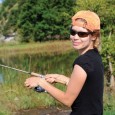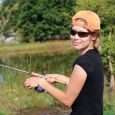The Gift of South Dakota
Subscriptions to South Dakota Magazine make great gifts!
Subscribe today — 1 year (6 issues) is just $29!
The Paddlefish Opener
 |
| Boats dot the Missouri River near Yankton for the annual paddlefish season opener on October 1. |
Fishing is often a solitary sport in South Dakota, where anglers drift and cast on massive reservoirs, or on prairie rivers that flow for hundreds of miles. That changes every Oct. 1, however, when hundreds of people gather along a very short stretch of the Missouri River for the opening of the month-long paddlefish season.
Paddlefish are filter-feeders, meaning they won’t bite traditional bait, so they are caught by snagging hooks that are cast into the tailwaters of Gavins Point Dam, just a few miles west of Yankton. Men and women cast and drag, again and again, somewhat like fly fishing but less ballet and more muscle. They fish from boats or the rock-strewn shore. Some stand atop a tall concrete wall on the north side of the dam. When a fish is caught, all the anglers and spectators watch.
Paddlefish is a primitive species that swam eons ago with the dinosaurs. Due to its size and shark-like appearance, it seems like a creature more fit for the world’s oceans rather than the lakes and rivers of middle America.
The largest ever caught was speared by an Iowa fisherman in 1916. It weighed 198 pounds. The South Dakota record is a 127-pounder landed by Bill Harmon in 2014 at Lake Francis Case. Hundred-pound fish measuring 4 to 5 feet are not uncommon.
 |
| Bryan Mendlik, Scott Mendlik and Kellen McClure caught and released a "slot" paddlefish below Gavins Point Dam that measured just under 45 inches. |
Landing such a large fish is no easy matter. On some occasions, it takes many minutes and several men. As soon as a fish is brought out of the water, the angler and his friends grab a tape measure, but they don’t stretch the tape along the paddle-like snout, which can be one-third of its overall length; the scientific measurement is from the eye to the fork in the tail.
The sport of paddlefishing is heavily regulated in South Dakota, and one of the rules states that fish between 35 and 45 inches must be immediately released because they are in their breeding prime. The six Missouri River dams greatly interrupted the natural spawning of the great fish. Much of the slack has been replaced by artificial breeding programs in hatcheries, but paddlefish do still breed in the wild.
Biologists want to give them every chance to do so, and the anglers obviously agree because there’s always an urgency to get every fish measured and then released when it’s within the range.
The snagging season at Yankton runs the month of October. There was a time when it began on Oct. 1 and then concluded after a certain quota of fish were harvested. That created a bedlam of action, as everyone rushed to snag a fish before the season ended. The river and shoreline became so congested that authorities deemed it unsafe.
Naturally, such mayhem created more regulations. Today only 1,600 licenses are made available in a June drawing. (A May season is held at Lake Francis Case, where just 350 licenses are allowed.)
License winners at Yankton now have the entire month of October to bag a fish, but opening morning is still a sight to behold — especially when it turns out to be a classic autumn morning with blue skies and gold leaves on the cottonwoods that shade the river.
Anglers and spectators alike mark Oct. 1 on their calendars.
Editor’s Note: This story is revised from the September/October 2022 issue of South Dakota Magazine. To order a copy or to subscribe, call (800) 456-5117.










Comments